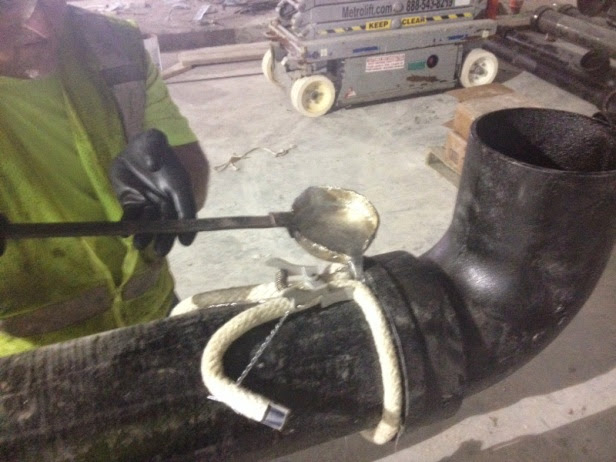What is a Sewergas Leak?
Having a sewer gas leak can be very frustrating, not to mention cause a terrible odor. It is also a health issue, if it is bad enough. So, what are the typical causes of sewer gas leaks, and what is it? A sewer gas leak is just that, a leak from the sewer system that is allowing sewer gas to leak out of a part of the drainage system. This can happen for a myriad of reasons. Let’s first look at how this happens. In this article, the terms sewer, drain, and waste are used interchangeably.
How a Sewer System Works
First, a quick description of how a sewer system works: There are a series of pipes below the floor of a building with plumbing fixtures within it that carry all the wastewater away to a septic tank or municipal sewer connection. As you probably already know, a sewer system and septic tank have strong odors in them and harbor gases and bacteria that are harmful to humans. These pipes are also connected to a vent system that helps to maintain equal pressure within the sewer system and to allow for sewer gases to escape to the atmosphere. The vent system should never have water flowing through it under normal conditions. The vent pipes extend above the drains in the walls and attic of a building and terminate above the roof. Oftentimes, multiple vents connect into one main vent stack to eliminate the need for multiple roof penetrations. A separation on any part of the vent system or the sewer system can allow for sewer gas to leak out into the building. If a break occurs on a drain pipe and not a vent, then the waste can also leak out, depending on where the separation is specifically. The other part of this system is the p-traps that keep from sewer gas escaping into the room they are located. A p-trap is a specially designed pipe that traps a specific level of water inside and is attached to a plumbing fixture, usually directly below the outlet of the fixture. All plumbing fixtures that connect to the sewer system must do so via a p-trap. Because the p-trap connects the fixture to a sewer system and the fixture is inside a building, there has to be a way to stop from the gases escaping into the building. This is accomplished with a p-trap that traps water in the pipe at a low point within it and stops the flow of sewer gases from escaping from the system. This only works if water is inside the p-trap and has not evaporated. See images below for a reference of a p-trap.
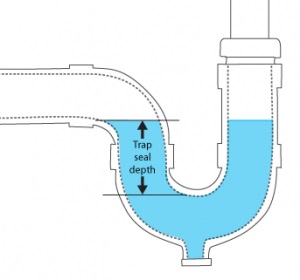
If a fixture is rarely used, like once a month or less, the water inside the p-trap can evaporate below the threshold of the trap, thus allowing for sewer gases to escape. Floor drains in commercial buildings are notorious for this issue because they only have water flowing through them when the floors are cleaned or if someone is aware of this potential and maintains it by intentionally pouring water down it periodically. If a room is rarely used that has a floor drain, it is common for water to not be put down the floor drain for months at a time. Most buildings built in the last 20 years have trap primers to help avoid this issue. Trap primers are installed usually during initial construction. These devices add water to the trap through a special device every time water pressure drops below a specific setting. There are other products on the market today that provide the same protection against a floor drain drying up that are much less invasive than installing a trap primer and can easily be retrofitted. When determining the cause of a sewer gas leak, we first must confirm that all traps are present and have water in them at the proper level.
When a sewer and vent system is first installed, it is tested for water tightness and proper support. But that does not mean it will always stay that way. Ground shifting, house leveling, droughts, remodels, shoddy repairs, etc, are all causes of sewer gas leaks. The symptoms can be sporadic and don’t always show themselves immediately or consistently. Air movement due to temperature changes, air conditioning, and heating systems, doors opening and closing, ceiling fans, etc, all contribute to how a sewer gas leak can become apparent to the inhabitants of the building. Because it is a gas leaking and not a liquid, it can be very difficult to identify a sewer gas leak. When we go to a call for a sewer odor, we first have to determine if we are in fact dealing with a sewer gas leak and not a dead animal in a wall. Another thing to consider is that just because a smell is prevalent in one area does not necessarily mean that the leak is in that vicinity. As previously stated, air movement can cause the smell to migrate.
Detecting Leaks
The best way to determine the source of the leak is to perform a smoke test. This is done with equipment designed specifically for performing this test and uses inert smoke that is induced into the drain and vent system through a vent or a sewer cleanout. The smoke is dense and will leak through the separation that is allowing the sewer gas to leak, thus making it apparent to the plumber where to start looking. Often, these leaks are inside walls or ceilings so it is necessary to cut open walls to find the exact source of the leak. It is oftentimes necessary to perform multiple tests on a system to narrow down the location or if there are separate systems that are not all connected to one sewer. Even after a leak is repaired, another test may be performed in order to confirm that no more leaks are present as it is a process of elimination. Once one leak is fixed, another leak may still be present but not as obvious due to a worse leak allowing most of the smoke to escape.
If a smoke test does not expose a leak and there is still a strong feeling that a leak does exist on the sewer system, a hydro-static test can be performed on the sub-slab drains. This is a basic test that involves adding water to the drains below the floor or slab and plugging off the main outlet of the sewer. Enough water is induced into the system to fill it entirely to right below the top of the floor below the fixtures.
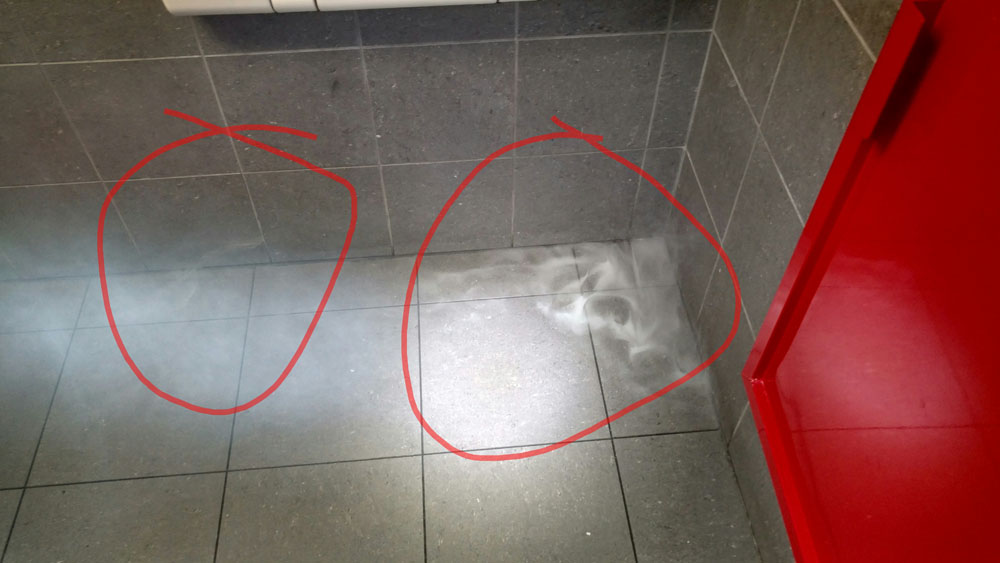
Then, through the access point used to plug the sewer for filling, we make a mark to see where the water is and watch it for 15-20 minutes to see if it drops below our mark and where it stops. This is for testing only the drains below the floor. A side note: a sewer gas leak on the sewer below a slab can be bad enough to where a smoke test will expose it. I have personally seen this and have the photos showing the result below.
Common Sources of a Sewer Gas Leak
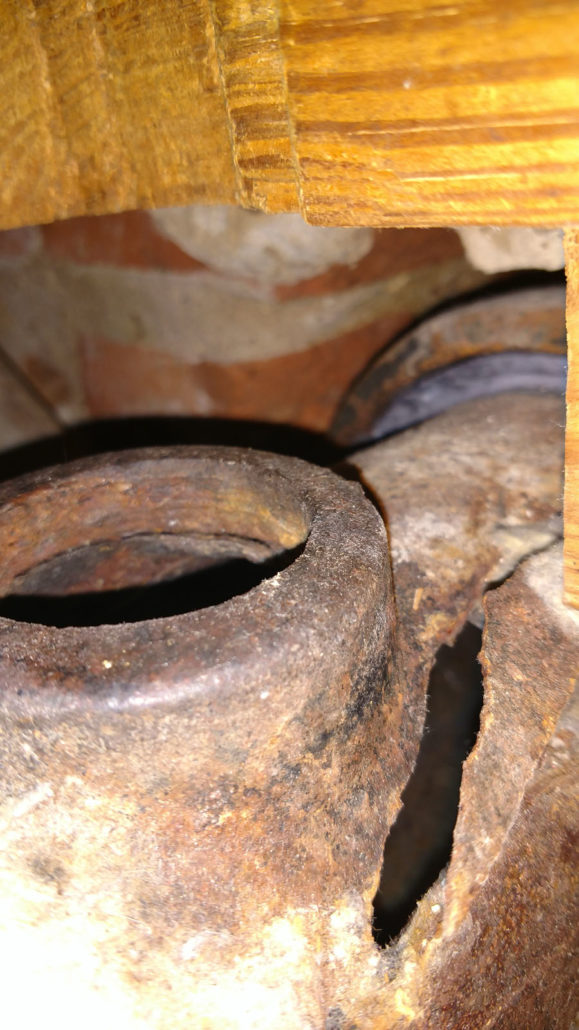
What are some common sources of a sewer gas leak? An extremely common source is toilets. A toilet is sealed to the sewer system with a wax seal or neoprene seal. Over time, these can go bad and no longer seal the toilet to the sewer. When this happens, it is not always obvious because water usually won’t leak out, only sewer gas, unless there is a clog in the system and water backs up into the drain below the offending toilet. One thing we will test when there is a sewer gas leak is a toilet to see if it is loose. Even if a toilet is solid to the floor, it can still have a minor leak at the seal but a loose one is more prone to leaking. There are ways to help determine if a toilet is an issue without doing a smoke test, such as, running water down another fixture drain in the same bathroom and listening for water flowing through the system by putting your ear near the base of the toilet where it meets the floor. If the sound of water flowing through the system is audible, there is a good chance that the toilet is the issue. You should not clearly hear water flowing through the pipes after a fixture is used. The toilet’s seal and trap are meant to stop any sewer gases from escaping and also make it almost inaudible to hear water flowing through the system under normal circumstances. So if you can hear it clearly, then it’s a good sign that the toilet is the offender. This is not a guaranteed method but it helps to start narrowing it down.
A second very common cause of a sewer gas leak comes from the installation of mirrors, cabinets, or anything that is nailed or screwed to a wall in a bathroom or near a plumbing fixture where the sewer and vent pipes are made of PVC or ABS (plastic), or copper pipe. Due to the thickness of cast iron pipe, it is extremely difficult to get a screw or nail through it so this is typically not an issue with cast iron pipes. What will happen is a screw is put unknowingly into a vertical vent or drain pipe that is located inside a wall. The leak may not occur for some time because the screw has sealed itself. After enough time and exposure to sewer gas or liquid waste, the screw rots off and now a hole is exposed. If a screw is driven through a vent pipe that has no liquid running through it, it may be a long time before the issue presents itself. If it is a drainpipe, it will not take as long but can cause a lot of damage prior to being discovered due to the fact that water is not continually running through the pipe. What we will typically find, if it is a drain pipe, is discoloration on the wall below the hole and a bad odor. Sometimes a sewer inspection camera can be used to determine this issue but a smoke test is usually the best method.
Another very common cause of sewer gas leaks are shoddy remodels where old drains are abandoned or simply cut off and not properly capped. We Another very common cause of sewer gas leaks are shoddy remodels where old drains are abandoned or simply cut off and not properly capped. We have seen this time and time again on homes and businesses. Example: a bathroom will be gutted and fixtures relocated where the old system is cut but never permanently capped. We have seen old sewer pipes left under a slab, inside a wall, or simply left as they were originally and built over without a second thought given to the fact that a p-trap will eventually dry up and allow sewer gas to escape. Turning an old bathroom or storeroom with a floor drain into an office space or living space but never sealing off the old floor drain is common. This can become apparent if the main drain clogs or due to sewer gas leaking out after the water in the floor drain p-trap finally evaporates.
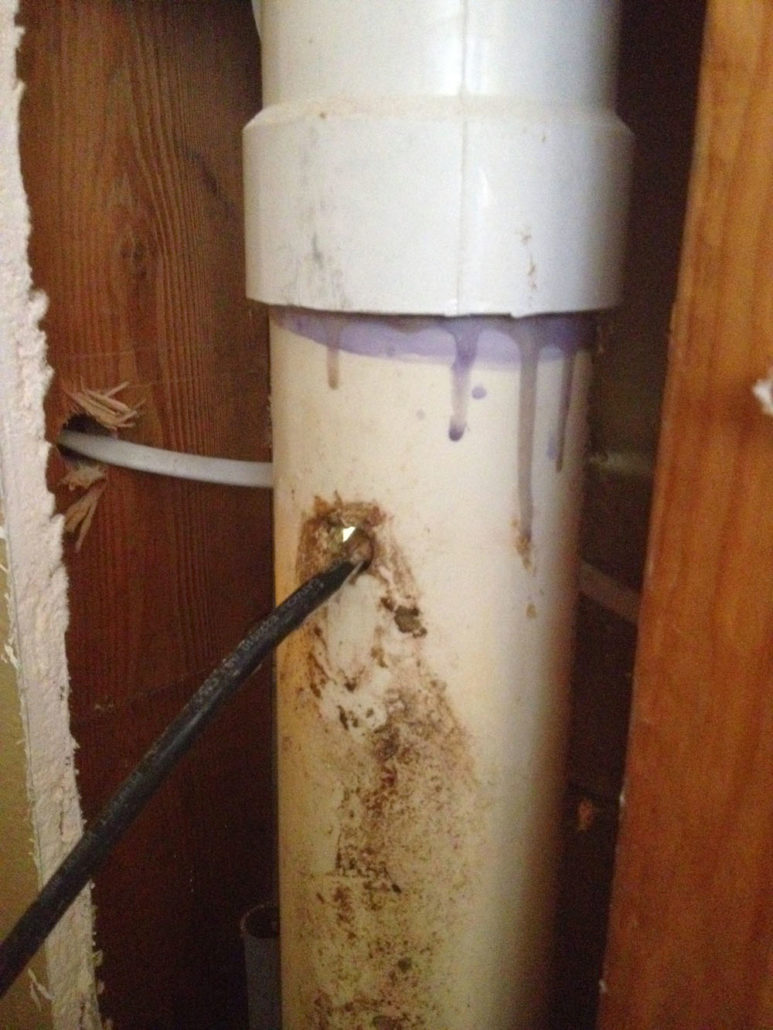
Cast Iron Sewer Pipes
A more egregious cause of sewer gas leaks is not installing a p-trap for a fixture, like a kitchen sink or bathtub. In my career, I have seen many remodels on kitchens or bathrooms where no trap was installed for bathtubs or sinks. As previously stated, all plumbing fixtures must connect to the sewer system via a p-trap. If the drain connects directly into the sewer system with no protection against sewer gases escaping, it can be a major health hazard. What I have seen many times is a service call will come in for a bad odor in a newly remodeled bathroom or kitchen. After some quick inspections, it will be determined that no trap exists for a fixture. I have countless stories of bad remodels where this exact scenario is the case and, unfortunately, often it is on flipped homes or rent houses. The home flipping trend in the last ten years has allowed for many DIY plumbers to assume merely because they can put pipes together that they understand how it works and how to properly put them together with the proper parts. This has caused a lot of grief for the new owners buying a home or building that they think is all new and updated, only to find out that they now have a health issue due to shoddy plumbing AND they will now have to spend more money to fix it right. It is a major health issue to have sewer gases leaking into places where humans are and ought not to be taken lightly.
The main thing to understand when dealing with a sewer gas leak is that it is a process of elimination and there is no guarantee that it will be found quickly or on the first try. If you are having sewer smell issues, feel free to call us for a consultation.
